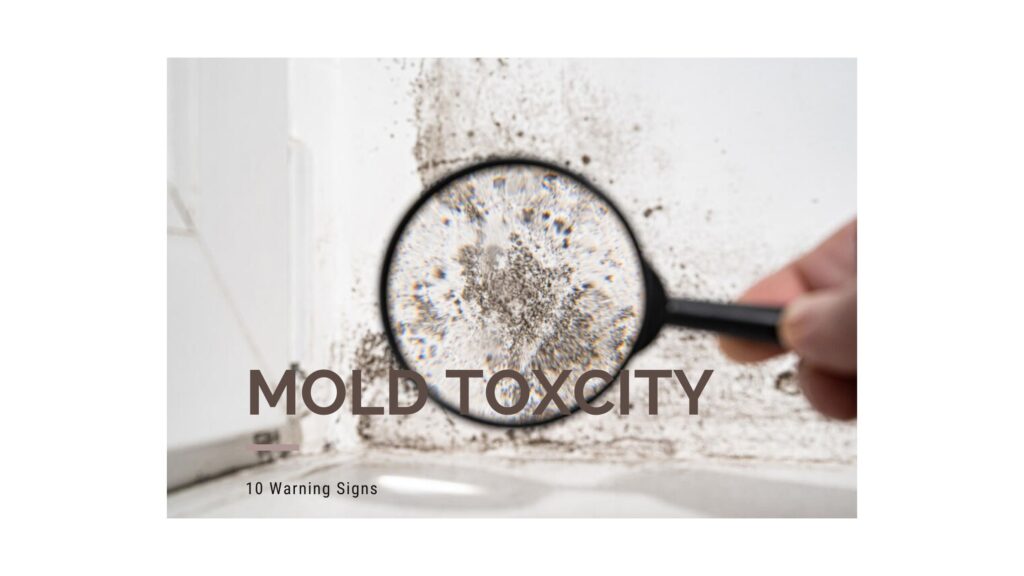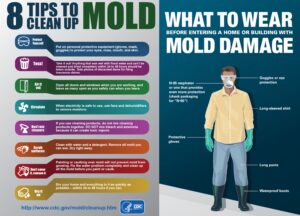Mold Toxicity is a serious health concern that is often overlooked, particularly for those exposed to mold for a long duration of time. Mold, a type of fungus (Cavalier-Smith, 2001), thrives in damp and poorly ventilated spaces, releasing airborne spores, which cause various health issues. While not all molds are toxic, certain varieties can produce mycotoxins, which are harmful substances for both humans and animals (Campbell et al., 2004).
These mycotoxins can result in mold toxicity or chronic inflammatory response syndrome (CIRS). Early recognition of the warning signs of mold toxicity can help you seek treatment before the condition worsens. Here in this blog post, we will discuss 10 warning signs of mold toxicity that you may be experiencing.
10 Warning Signs of Mold Toxicity
Respiratory Issues
One of the most common signs of mold toxicity is respiratory issues. Mold spores can irritate the lungs and airways (Park et al., 2004), causing symptoms such as
- Chronic Coughing
- Weezing
- Shortness of breath
- Asthma-like reactions
If you notice that your breathing problems worsen in certain environments, like your home or workplace, mold could be the culprit.
Chronic fatigue
Mold toxicity can also drain your energy levels. Those exposed to mold often report persistent fatigue, even after a full night’s sleep (Campbell et al., 2004). This overwhelming tiredness can disrupt daily activities and, unlike regular fatigue, doesn’t improve with rest. This occurs as your body’s immune system works overtime to combat the toxins produced by mold.
Sinus Problems and Headaches
Mold spores can irritate the sinuses, which leads to frequent nasal congestion, sneezing, and sinus headaches (Mark et al., 2004). If you experience
- Blocked or runny nose
- Sinus pressure
- Frequent sinus infections
- Postnasal drip
- Pressure around your eyes
These may be warning signs of mold toxicity. In some instances, these sinus issues can also result in persistent, unexplained headaches.
Cognitive Difficulties (Brain Fog)
Exposure to toxic mold can affect cognitive functions, which often results in what is commonly known as “brain fog” (Andrew et al., 2004). This may present as:
- Difficulty concentrating
- Memory problems
- Confusion
- Trouble focusing on tasks
- Mental sluggishness
Mold toxins can disrupt the brain’s neurotransmitters, potentially contributing to cognitive decline.
Skin Irritation
Mold toxicity doesn’t just impact the respiratory system, the prolonged exposure can also result in skin issues like
- Redness
- Itching
- Unexplained rashes
- Hives
- Dermatitis
These reactions may occur when mold spores directly contact your skin or when your body responds to the toxins internally (Jarvis et al., 2002). Skin irritation is a significant warning sign, particularly if it coincides with time spent in a mold-prone environment.
Joint Pain and Muscle Aches
Mold toxicity can trigger inflammation responses in the body, which results in symptoms that resemble those of autoimmune conditions like rheumatoid arthritis (Luosujärvi et al., 2003). Individuals exposed to mold may experience
- Unexplained joint pain
- Muscle stiffness
- Body aches
These symptoms can intensify with continued exposure, creating a cycle of chronic pain and discomfort.
Mood Swings and Anxiety
Another lesser-known but significant symptom of mold toxicity is its impact on mental health. The mycotoxins released by mold can disrupt the brain’s neurotransmitter production, affecting mood regulation (Coreen et al., 2010). This may result in
- Increased irritability
- Anxiety
- Depression
- Sudden mood swings
If you notice a decline in your mental health without a clear cause, mold toxicity could be a factor to consider.
Digestive Issues
Mold exposure can also cause gastrointestinal problems (Mazur et al., 2006), with symptoms including
- Nausea
- Vomiting
- Diarrhea
- Abdominal Pain
- Bloating
These digestive issues may arise from the body’s reaction to mycotoxins, which can irritate the stomach lining or disrupt the balance of gut bacteria.
Increased Sensitivity to Chemicals and Smells
Individuals facing mold toxicity often develop a heightened sensitivity to everyday chemicals, smells, and even foods, a condition known as multiple chemical sensitivity (MCS) (Bush et al., 2006). This can make it challenging to tolerate substances like perfumes, cleaning products, or cigarette smoke. Such increased sensitivity may also trigger allergic reactions or exacerbate respiratory symptoms.
Frequent Infections
Mold toxicity can weaken the immune system, increasing your susceptibility to frequent infections (Bush et al., 2006). Recurring colds, sinus infections, or persistent respiratory infections may indicate mold exposure. When the body continually battles mold spores and toxins, the immune system becomes overworked, making you more vulnerable to other illnesses.
How to Protect Yourself from Mold Toxicity
If you suspect mold toxicity, it’s crucial to take steps to address both the health impacts and the environmental source of mold. Here are a few key steps you can take:
Identify and Eliminate Mold Sources
Conduct a comprehensive inspection of your home or workplace to identify areas that are prone to mold growth. Mold flourishes in damp, poorly ventilated spaces, such as basements, bathrooms, and kitchens.
Look for signs of moisture, such as water stains or condensation. If you find any leaks, make sure to address them promptly to prevent further water accumulation. Additionally, ensure that these humid places have adequate ventilation to promote airflow and reduce moisture levels. This proactive approach can help prevent mold from taking hold in your home or workplace.
Use Air Purifiers
Invest in a high-quality air purifier equipped with a HEPA filter, as it can effectively remove airborne mold spores from your home or workplace. This type of filter is designed to capture small particles, including mold spores, thereby improving indoor air quality and reducing the risk of mold-related health concerns. By using an air purifier, you can create a healthier living environment for your loved ones and minimize the presence of allergens and irritants.
Seek Medical Treatment
Consult a healthcare provider, ideally one experienced in mold toxicity, to conduct the necessary tests and develop a tailored treatment regime. Medical interventions may include antifungal medications, detox programs, and dietary adjustments designed to support your body’s recovery from mold exposure. Working with a knowledgeable professional can help ensure you receive appropriate care and guidance throughout the healing process.
Mold Testing
Professional mold testing can identify the type and level of mold exposure in your home or workplace. If mold is detected in your environment, you may need to engage professional remediation services to safely and effectively remove it. This ensures that the mold is dealt with properly, minimizing the risks and preventing its future growth. For a mold testing kit guide, visit our blog post on Mold Test Kit: A simple guide for your home and health.
Conclusion
Mold toxicity is a serious health condition that can present in various ways, including respiratory issues, fatigue, cognitive decline, and mood disturbances. If you notice any of these 10 warning signs of mold toxicity, it is crucial to address the problem promptly. Reducing mold exposure and seeking appropriate medical treatment can significantly enhance your well-being and aid in your recovery.
By recognizing the early symptoms and taking action to eliminate mold, you can protect yourself and your family from the harmful effects of mold toxicity.
FAQs
-
What is mold toxicity?
Mold toxicity is a condition where exposure to mold spores or toxins affects health, causing various symptoms. - What are common signs of mold toxicity?
Symptoms may include fatigue, headaches, respiratory issues, and brain fog. - Can mold toxicity affect mental health?
Yes, mold exposure can lead to cognitive issues like memory loss and mood swings. - What causes mold toxicity symptoms?
Inhaling mold spores and mycotoxins from contaminated indoor air can cause symptoms. - How is mold toxicity different from allergies?
Allergies cause immediate symptoms, while mold toxicity can result from prolonged exposure and impact overall health. - Can mold toxicity cause digestive issues?
Yes, it may lead to nausea, abdominal pain, or food sensitivities. - Is skin irritation a sign of mold exposure?
Yes, rashes or skin irritation can result from mold exposure. - Who is most at risk for mold toxicity?
Individuals with weakened immune systems, respiratory issues, or allergies are more susceptible. - How can I test for mold toxicity?
A healthcare provider can conduct tests, including urine tests for mycotoxins. - What should I do if I suspect mold toxicity?
Seek medical advice, avoid mold exposure, and consider professional mold remediation.
Thanks for reading, for more interesting articles please visit our homepage.





Pingback: Mold Test Kit: A Simple Guide to Protecting Your Home and Health
Pingback: Understanding Floor Joist: Types, Benefits, and Common Issues
Pingback: Wall Material Underlayment Rolls: Insulation & Soundproofing